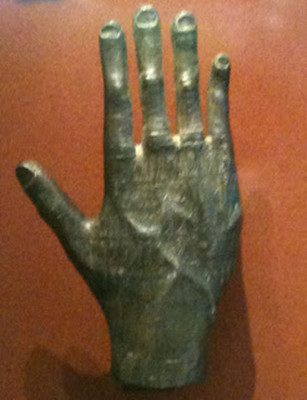Both frankincense and myrrh were very expensive. A pound of frankincense cost the equivalent of a Roman labourer's salary for a month, and a pound of myrrh twice as much. So when the magi bring frankincense and myrrh to the infant Jesus, they're bringing not only gifts fit for a god - they're also as valuable as their other gift, gold.
乳香和沒藥都十分昂貴。一磅乳香的價格等同于一個羅馬勞工一個月的工錢,而一磅沒藥的價錢是它的兩倍。因此,當東方三賢將乳香和沒藥帶給剛出生的耶穌時,他們送上的不僅是合適的敬神之物,而且價值也像他們另外送上的黃金一樣珍貴。
We've got no contemporary written sources, but this hand, other pieces of bronze sculpture of similar quality, and the ancient industrial slag recently discovered in south Arabia, show that Yemen was then a major centre of bronze production. Wahab Ta'lab's hand is clearly the product of skilled metal-workers. If you look at it carefully you can see that it's been cast using the lost wax technique, and very beautifully finished at the wrist. So our bronze hand is definitely a complete object, not a fragment broken off from a larger sculpture.
除了銅手上這種簡短晦澀的銘文之外,古代也門沒有給我們留下任何書面文獻。但眾多質盤相當的青銅工藝品以及最近在阿拉伯南部發現的古代工業礦渣堆,證明當時的也門也是一個青銅制造中心。瓦哈·塔拉布的手一定是工藝嫻熟的金屬加工匠的作品。仔細觀察,你會發現它曾使用了脫蠟工藝,且腕部有精細打磨的痕跡,證明它并非某件大型工藝品的一部分,而是一件完整的作品。
Offering replica body parts to the gods is by no means peculiar to Arabia. You find them in Greek temples, in medieval pilgrim shrines and in many modern Roman Catholic churches - used to ask a god or a saint for bodily healing or as a thank-you for recovery. So perhaps Wahab Ta'lab wanted his broken finger healed, although the inscription suggests that it was a broader prayer, for general good health.
向神靈敬獻自己身體某一部分的復制品并非阿拉伯人獨有的做法。在希臘神廟、中世紀神壇以及現代羅馬天主教堂里都能看到類似的供品, 用于向神或圣人祈求病體康復,或用于康復后的還愿。
Wahab Ta'lab's hand speaks to us from a religious world that was dominated by local gods, who looked after particular places and peoples. But it was a world that wasn't going to last.
瓦拉·塔拉布獻上自己的手時,他們的信仰世界還處于本土神庇佑一方子民的時代。但這樣的時代很快便要終結了。












